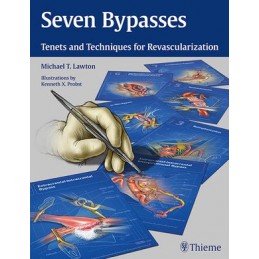- Obniżka


 Dostawa
Dostawa
Wybierz Paczkomat Inpost, Orlen Paczkę, DHL, DPD, Pocztę, email (dla ebooków). Kliknij po więcej
 Płatność
Płatność
Zapłać szybkim przelewem, kartą płatniczą lub za pobraniem. Kliknij po więcej szczegółów
 Zwroty
Zwroty
Jeżeli jesteś konsumentem możesz zwrócić towar w ciągu 14 dni*. Kliknij po więcej szczegółów
Seven Bypasses:: Tenets and Techniques for Revascularization is the third book in a trilogy of bravura, technical nuance, and strategy by master neurosurgeon Michael Lawton. Like his first two books on aneurysms and AVMs, Seven Bypasses provides unparalleled firsthand insights and guidance on complex pathologies in vascular neurosurgery. The fundamentals of microsurgical anastomosis and the craft of bypass surgery are explored in depth with clinical pearls in every chapter.
Lawton eloquently reveals the art of cerebral revascularization in exquisite, metaphorical detail. The surgeon performing bypass surgery is like an architect envisioning and building a beautiful structure. A bypass is designed to fit the patients unique anatomy; blueprints designate anastomotic sites, connections, and conduits; the anastomoses are constructed; and the bypass is brought to life with pulsations, flow, and reperfusion. The book highlights Lawtons aesthetic, which has evolved from the common STA-MCA bypasses to IC-IC bypasses and elaborate arterial reconstructions.
Key Highlights
Dr. Lawton has bequeathed a remarkable treasure of knowledge to current and future generations of neurosurgeons and their patients. The Seven series is destined to be an enduring classic for residents, fellows, and neurosurgeons specializing in the treatment of cerebrovascular disease, and for those who believe that manual dexterity and technical skill still matter.
Opis
Section I: Three Anastomoses
1 End-to-Side Anastomosis
2 Side-to-Side Anastomosis
3 End-to-End Anastomosis
Section II: Ten Tenets
4 Dexterity
5 Donors and Recipients
6 In the Zone
7 Cross Clamp
8 Arteriotomy
9 Suturing Techniques
10 Tissue Handling
11 Tightening and Knotting
12 Bypass Patency
13 Aneurysm Occlusion
Section III: Seven Bypasses
14 Extracranial-Intracranial Bypass
15 Extracranial-Intracranial Bypass with Interposition Graft
16 Reimplantation
17 In-Situ Bypass
18 Reanastomosis
19 Intracranial-Intracranial Bypass with Interposition Graft
20 Combination Bypasses
Section IV: Bypass Strategy
21 MCA Bypass Strategy
22 ACA Bypass Strategy
23 Basilar Artery Bypass Strategy
24 PICA Bypass Strategy
Section V
Conclusion
